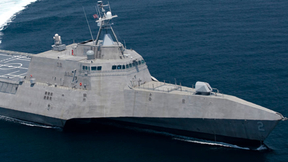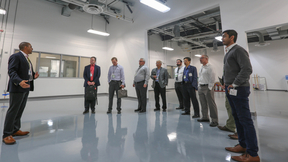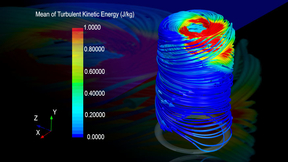Back
Secretary of Energy Rick Perry recognized Lawrence Livermore National Laboratory (LLNL) chemist Bill McLean with a Secretary’s Achievement Award Wednesday in recognition of "pioneering technical contributions that have led to significant advancements in science-based stockpile stewardship." The Secretary’s Honor Awards are bestowed on individuals who have a singular…
Lawrence Livermore National Laboratory (LLNL) has issued a special High Performance Computing for Manufacturing (HPC4Mfg) call for proposals for projects aimed at addressing key challenges in U.S. steel and aluminum manufacturing. The solicitation officially opened on Aug. 23. Funding of up to $1.2 million will be made available from the Advanced Manufacturing Office of…
Artificial neural networks are all around us, deeply embedded in routine functions on the internet. They help online merchants make personalized shopping recommendations, enable social media sites to recognize faces in photos and assist email programs in filtering out spam. Neural networks also have the potential to play a critical role in national security, helping…
Through the emerging field of optogenetics, a technology that allows genetically modified neurons in living tissue to be precisely controlled by means of light, scientists are attempting to gain a better understanding of how the brain works in hopes of discovering cures for debilitating neural disorders such as post-traumatic stress disorder (PTSD) and Alzheimer’s disease…
Graphene aerogel is lighter than air but as strong as steel, and it’s already proven useful in aerospace, energy storage and insulation. While there have been recent advances in 3D printing of the novel material, achieving complex structures has been elusive, hampering the unique material’s full potential. To date, 3D printing of graphene aerogel has been done using direct…
The Food and Drug Administration has approved the use of a medical device in humans for deliberately blocking blood flow to treat bleeding abnormalities or other conditions, a procedure known as embolization. The device integrates expanding shape memory polymer technology that was partly developed at Lawrence Livermore National Laboratory (LLNL). The FDA recently granted…
A new study in which Lawrence Livermore National Laboratory (LLNL) scientists compared drug responses in the brains of rodents to drug responses of brain cells cultured in Lab-developed "brain-on-a-chip" devices may be a critical first step to validating chip-based brain platforms, LLNL researchers said. In the study, published online today in the journal Scientific…
The program to extend the life of the W80 nuclear warhead recently achieved a significant milestone when the National Nuclear Security Administration (NNSA) gave passing grades to the plans to refurbish certain components and the proposed approach to developing component cost estimates. Passing the milestone confirms that the life extension program (LEP), dubbed the W80-4…
Growing up in the Central Valley, the son of Mexican migrant farmworkers, José Hernández learned early on that education would be his ticket out of a life toiling in the fields. His journey would lead him to a 15-year career at Lawrence Livermore National Laboratory (LLNL), to the zero-gravity of low-earth orbit aboard the space shuttle Discovery, and to a congressional…
In a development with the potential to enable breakthroughs in lithium-ion batteries and further impact a wide swath of research areas, Lawrence Livermore National Laboratory (LLNL) scientists have developed a new open source software application that can, in real-time, compute, analyze and potentially predict the trajectories of atoms during the course of bond breaking…
Researchers at Lawrence Livermore National Laboratory (LLNL) are lending their expertise in metal additive manufacturing to a new collaboration aimed at 3D printing critical replacement parts for the U.S. Navy. The Office of Naval Research recently announced an award of $9 million to fund a collaboration led by GE Global Research and aimed at developing a rapid process for…
Representatives from more than 30 companies in the additive manufacturing (3D printing), automotive and aerospace industries got their first glimpse last week at Lawrence Livermore National Laboratory’s (LLNL) newest facility, the Advanced Manufacturing Laboratory, located in the Livermore Valley Open Campus (LVOC). The sneak preview was part of a "Partnering for Success"…
Additive manufacturing (AM) has gone to the dogs, thanks to Lawrence Livermore National Laboratory’s (LLNL’s) new approach to K-9 training materials. The process prints 3D objects that contain trace amounts of nonreactive explosives, resulting in several advantages for K-9s and their handlers. Chemist John Reynolds leads a team of LLNL scientists and engineers who recently…
Machine learning. Deep learning. Artificial intelligence. Computer vision. Big data analytics. These aren’t just techie buzzwords — they’re all areas of research that fall under the sweeping term "data science." So how does a national laboratory, with researchers exploring all of these areas and more, coalesce these disciplines into a unified group? Launched earlier this…
For the first time, researchers at Lawrence Livermore National Laboratory (LLNL) have successfully 3D-printed optical-quality glasses, on par with commercial glass products currently available on the market. In a study published in the journal Advanced Materials Technologies, LLNL scientists and engineers describe successfully printing small test pieces from Lab-developed…
The drones whizzed, hovered and soared, racing around a circular "track" and dropping ball-bearings on tarpaulin targets from high above. Four teams, comprised of engineering students from Cal Poly-San Luis Obispo were going head-to-head in a Lawrence Livermore National Lab-sponsored Design Challenge, putting their custom-built drones to the test with scholarships, awards…
A team of firefighters clears a building in a blazing inferno, searching rooms for people trapped inside or hotspots that must be extinguished. Except this isn’t your typical crew. Most apparent is the fact that the firefighters aren’t all human. They’re working side-by-side with artificially intelligent (AI) robots who are searching the most dangerous rooms, and making…
The Department of Energy (DOE) on Feb. 1 announced up to $3 million will be available to U.S. manufacturers for public/private projects aimed at applying high performance computing to industry challenges for the advancement of energy innovation. The funding represents the latest round of solicitations for the High Performance Computing for Manufacturing (HPC4Mfg) program,…
Lawrence Livermore National Laboratory (LLNL) researchers have discovered novel ways to extend the capabilities of two-photon lithography (TPL), a high-resolution 3D printing technique capable of producing nanoscale features smaller than one-hundredth the width of a human hair. The findings, recently published on the cover of the journal ACS Applied Materials &…
Thin-film microelectrode arrays produced at Lawrence Livermore National Laboratory (LLNL) have enabled development of an automated system to sort brain activity by individual neurons, a technology that could open the door to recording and analyzing unprecedented amounts of neural signals over time, and, ultimately, provide scientists with new clues about how the brain…
























